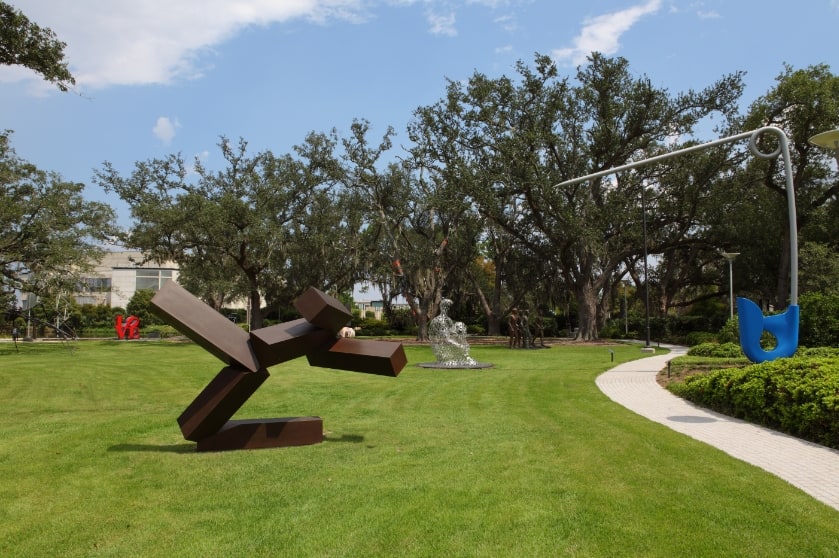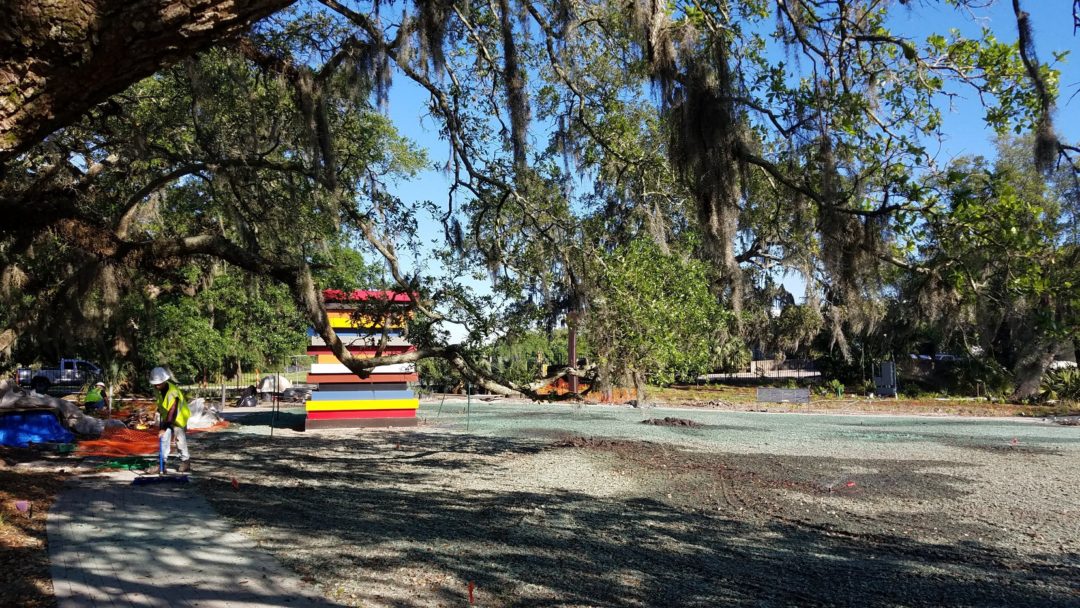The weather’s approaching peak beauty and this is primo time to get out there and enjoy it. But how?
Well, you could get boozy drinks with your buddies at one of New Orleans’ many outdoor watering holes, of course. Or maybe you could head Uptown to The Fly and set up a picnic, toss the Frisbee, and enjoy the bucolic riverside scene: not too shabby!
Or you could try something different!
The last Saturday in April happens to be International Sculpture Day — a worldwide celebration dedicated to advancing the creation and understanding of sculpture and its unique, vital contribution to society.
But you’re a cultured person! Do you only go outside and admire art on special holidays?
We didn’t think so! And, fortunately, New Orleans has tons of opportunities to enjoy what English artist, Henry Moore called, “an art of the open air” any day of the week.
So here are just a few of our favorite examples:
Sydney and Walda Besthoff Sculpture Garden
On May 15, the Sydney and Walda Besthoff Sculpture Garden will unveil their much-anticipated 6.5-acre expansion to the public. But before we get to that, let’s take a look at the longtime home to dozens upon dozens of primarily 19th and 20th century sculptures from around the world — valued at more than $25 million!
It’s that collection of art, almost entirely donated by philanthropists Sydney III and Walda Besthoff — combined with a landscape that has delighted visitors to City Park for 165 years — that has made this New Orleans gem one of the most highly rated sculpture gardens in the world.Believe it or not, the story of this sculpture garden actually begins in the corporate headquarters of a drugstore chain called K&B Incorporated. K&B (Katz and — you guessed it — Besthoff) was founded by a pair of partners that included Sydney’s grandfather, back in 1905.
Sydney served as chairman and CEO of the business and in 1973, K&B acquired an office building at Lee Circle (still called “K&B Plaza” today, even though the Besthoffs have since sold the property). Included with the building was an 18-foot-high granite fountain designed by artist Isamu Noguchi, called The Mississippi, that is meant to illustrate water spilling from its crescent-shaped top to signify the river’s shaping of New Orleans.
However, the water feature wasn’t functioning properly when Besthoff purchased the property, and he said the investigation into its repair is what originally sparked his interest in sculptures!
Shortly after, Besthoff and his wife, Walda, commissioned their first two sculptures, and they began traveling through Europe, looking for works to add to their growing collection. They installed the larger works in K&B’s plaza, and displayed the smaller pieces inside of the building.
In addition to a burgeoning love of sculptures, the Besthoffs were also active philanthropists. Sydney joined NOMA’s board in 1992. By then, Besthoff had already been in discussion with the museum about a space for the public to enjoy the works he and Walda had collected over the previous two decades.
A lease agreement was signed in 1997, the designers of the space were named in 1998, and later that year, the Besthoffs donated the initial 24 sculptures.
Finally, on Nov. 23, 2003, the garden’s gates opened to the public and over the years it’s become a treasure to the City of New Orleans. The sculpture garden is open — totally free of charge — from 10 a.m. to 5 p.m., seven days a week! Visitors can enjoy world-class art while walking along a peaceful lagoon and through five acres of pines, magnolias and Spanish moss-laden live oaks.
Today, that original segment of the space now houses 64 sculptures, and its commitment to presenting breathtaking art in a relaxed and authentically Louisiana setting attracted more than 142,000 visitors in 2018!
The Poydras Corridor Sculpture Exhibition
Funded and presented by The Helis Foundation since 2013, The Poydras Corridor Sculpture Exhibition is a series of public art that lines Poydras Street from Convention Center Boulevard in the CBD, all the way toward Galvez Street in Mid City.
The collection is an initiative of Sculpture for New Orleans, founded by sculptor, Michael Manjarris, after Hurricane Katrina, with the mission of lifting the spirits of the people of New Orleans through public art, as well as providing local and regional artists the opportunity to present their work in a public venue.
Along with Sculpture for New Orleans and The Helis Foundation, the Ogden Museum of Southern Art and the city’s Department of Parks and Parkways have collaborated to bring one of the South’s leading rotating sculpture exhibitions to NOLA!
Art admirers can walk along the vibrant thoroughfare any hour of the day or night, taking in some or all of the 16 sculptures that currently line the street. Since the exhibition’s founding, 33 works — by artists of local and international acclaim — have been displayed for our enjoyment.
Works include everything from a bold, balanced gymnast and a massive red bunny, to a stack of bright, colorful diamond-shaped figures and a stairway reaching toward the stars.
This week, the Poydras Corridor Sculpture Exhibition welcomed a new piece to its collection, and welcomed it back to the city of New Orleans after a long hiatus. “Box with Artificial Flowers #6” by Ida Rittenberg Kohlmeyer was once displayed at the New Orleans Museum of Art’s reflecting pool, before being purchased by collectors in Chicago 35 years ago.
Now it’s back in our city, to be proudly displayed on the corner of Poydras Street and Loyola Avenue!
The Bread Woman
I might be cheating on this one. But what’s the difference between a statue and a sculpture?
Are they interchangeable? Probably not.
Are statues more like dedications to specific people and events, while sculptures are more abstract and artistic? Maybe.
Maybe all statues are sculptures, but not all sculptures are statues?
That’s what I’m going to go with — but feel free to call me out in the Comments Section on our Facebook page for this article if you feel like I’m a complete idiot.
One woman who was definitely not a complete idiot was Margaret Haughery — born into poverty in Ireland in 1813. When she was 5 years old, she immigrated with her family to America — as many Irish did during these decades — and ended up in Baltimore, Maryland. Unfortunately, when she was just 9 years old, both of her parents died during a Yellow Fever outbreak, and poor Margaret was orphaned.
She married at the age of 21, and convinced her husband — who was in bad health — that a warmer climate might do him well. They moved to New Orleans, and the change of scenery did appear to help him recover. They even had a child.
Unfortunately, the recovery was short-lived. Margaret’s husband died and — worse yet — her child died just a few months later. Still only 23 years old, Margaret’s family was wiped out for the second time in her life.
This is when Margaret — who barely had enough to support herself — turned to charity.
She began working as a laundress and — aware of how many New Orleans children were being orphaned at the time due to yellow fever and malaria — she donated a portion of her earnings to a local orphanage.
When she saw the children needed milk, she purchased two cows and began working in the milk delivery business. When she saw they needed bread, she purchased a bakery. She continued to donate goods as well as much of her salary, but her businesses were doing so well, she amassed a fortune.
She helped the poor, and she fed soldiers during the Civil War. In fact, Union Gen. Benjamin Butler once demanded a meeting with her, ordering her — under penalty of death — to stop crossing picket lines to deliver wagon-loads of bread and flour to hungry citizens of the city.
“Is it President Abraham Lincoln’s will to starve the poor?” she defiantly asked him.
“You are not to go through the picket lines without my permission, is that clear?” General Butler replied.
“Quite clear.”
“Okay. Then you have my permission,” he acquiesced.
In the next decades, Haughery went on to open four orphanages in New Orleans. She was beloved by the city, called “Saint Margaret,” “Mother to the Motherless,” “The Bread Woman,” “The Bread Woman of New Orleans,” “Head Mame,” “Margaret of Tully,” “The Angel of the Delta,” “Mother Margaret,” “Margaret of New Orleans,” “The Celebrated Margaret,”…the…okay, you get it.
And the sculpture made of her (a.k.a a statue) was dedicated on July 9, 1884, in the Lower Garden District, near where Prytania Street runs under the Crescent City Connection. It’s the very first publicly erected statue of a woman in the United States, the first monument to an American female philanthropist, and the only known statue to a baker.
The Sculpture Garden Expansion
Beginning on May 15, the Sydney and Walda Besthoff Sculpture Garden will more than double in size. The expansion includes an installation of 26 new pieces of art, 800 feet of bridges, and 2,800 feet of ADA-accessible paths. Inside you’ll find the planting of 65 new trees, 475 shrubs, 1.7 acres of ground covers, 1.13 acres of open lawn, and 9.35 acres of aquatic planting; as well as the creation of an indoor sculpture pavilion and an outdoor amphitheater with beautiful, grass-stepped seating.
The expansion also introduces nearly two acres of additional lagoon into the Garden, which NOMA hopes will add to the experience of their visitors. “A central element of the Sculpture Garden expansion is water,” said Margaux Krane, NOMA’s communications and marketing manager.
Krane explains there are several important ways in which the new sculptures are different from the original sculptures in the garden. For one, the original garden focuses on 19th and 20th-century works, while those in the expansion are almost all from the 21st century.
Additionally, the original Garden’s sculptures were selected from the Besthoff’s collection because of their significance to the larger narrative of the history of modern sculpture. These pieces in the expansion were chosen with this Garden in mind.
In fact, two works were even commissioned specifically for the Sculpture Garden’s expansion — including a translucent walking way, by Elyn Zimmerman, colored by several of the historic paths of an oscillating Mississippi River.
And this is just the tip of the iceberg! One of the unique characteristics about this Sculpture Garden has always been its commitment to bringing New Orleanians pieces of art from as near as New Orleans and as far as across the globe. The expansion will be no different.
But, in addition to bringing world-class art to New Orleans, the designers of this garden are constantly thinking of ways to bring more New Orleanians to the art.
“A lot of people consider art museums to be intimidating spaces,” Krane admits. “People tend to feel as if they aren’t welcome if they don’t know a lot about art. Even the literal facade of a museum can be formidable.”
The Besthoff Sculpture Garden has always been about introducing art to everyone. That’s why it’s free and open to the public seven days a week.
It’s also the reason behind several of the expansion-related design decisions. The hope is that see-through fencing and three new entrances will encourage those walking around City Park to stroll into the Garden.
That’s true of “even the Sculpture Pavilion,” Krane explained. “Sure, it’s going to allow us to display sculptures that can’t be exposed to weather elements — but we also hope it gives our visitors the experience of engaging with art indoors. And maybe that will create a bridge between the Garden and the museum around the corner.”
The grand opening of the expansion is set for 11 a.m to 5:30 p.m., May 15. The public is invited (of course!), and the event is totally free (also, of course!). Food trucks will be parked nearby, so swing by during your lunch hour — or for dinner — and enjoy the newest additions to what is becoming a long tradition of inspiring New Orleans sculptures.











